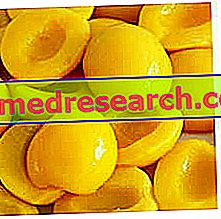Generality
The fruit in syrup is a sweet and preserved food based on fresh fruit. Some consider it a winter variant of seasonal fruit, but this is not exactly the case; the fruit in syrup, in fact - for the high energy supply, the high concentration of simple sugars and the culinary processing to which it is subjected - falls fully within the category of NOT fatty (but still caloric) sweets.

Unlike jams and jams, fruit in syrup requires the use of intact fruits, better if free of dents or abrasions, tending to low or medium ripeness; the fruit in syrup can be preserved whole, dividing the fruit in half or cutting it into pieces. On the contrary, jams and jams effectively play the role of "recycling" of the defective fruit, very mature, dented and always in excess; in this case, the fruit is cut, cooked, and eventually passed.
Theory and preparation of fruit in syrup
The conservative efficacy of canned fruit is based on two very distinct principles: one physical and one chemical. The physical one involves the use of heat with relative sterilization of fruit, syrup and jars; the chemical one, on the other hand, exploits the increase in the concentrations of sucrose (table sugar) which - considerably reducing free water - has a good bacteriostatic function.
In concrete, the fruit in syrup is washed, possibly peeled, cut, possibly pitted, placed in jars together with the syrup, cooked indirectly and sealed.
But is it really that simple?
In FIRST place, it is necessary to understand "how" and "how long" the canned fruit should be cooked.
How is it cooked? First of all, the fruit in syrup must be cooked in the special jars, filled with syrup and placed in a pan with boiling water. NB . These vases must be protected from each other with tea towels or old newspapers. Performing the same operation directly in the pan, out of the pots, the fruit would be exposed to excessive heat and it would be necessary to turn it often disrupting it and thus obtaining an "incomplete jam".
How long to cook? Readers will already be aware that the effectiveness of heat recovery depends on the time and temperature of the treatment; in fruit in syrup, the temperature is around 100 ° C, which is why the only variable on which to intervene is time. It is therefore necessary to understand IF the heat treatment to be applied is at least SUFFICIENT when stored, since poor cooking would NOT reach the restoration, while excessive cooking would tend to undo the fruit or pieces of fruit. Once boiling is reached, the time required is almost the same for each type of fruit, since heat always has the main function of destroying bacteria and molds (in this regard, just over 5 minutes is sufficient). In this regard, the most prepared readers could object: "boiling is ALSO necessary for the enzymatic denaturation of the pulp! If these catalysts are not blocked, browning of the fruit in syrup could occur even without the intervention of microorganisms". First of all, congratulations for the preparation ... but unfortunately, in this case, it is NOT so! The time it takes the water from the pan, and then the syrup of the pots, to reach the temperature is ALWAYS sufficient to make the heat penetrate to the center of the pulp, deactivating the enzymes responsible for hypothetical adverse reactions. For this reason it is sufficient to focus on the opposite problem, namely that the fruit is not destroyed by excessive cooking; for this purpose, it would be useful to have a very intense heat source that allows to reach 100 ° C quickly. WARNING! I do not recommend to immerse the jars of fruit in syrup in the water GIA 'to boil, because the thermal shock could cause the glass to break ... therefore a real disaster!
Another problem in the preparation of fruit in syrup is undoubtedly constituted by the calculation of the CONCENTRATION of the syrup, therefore by the control of "osmosis". If, in relation to the fruit used, the syrup is too low in sugar, the fruit tends to over-inflate; on the contrary, if the syrup is excessively concentrated, the fruit tends to become VASTLY evident. It is known that syrup, by definition, should have a concentration of 66.5% sucrose / glucose and 33.5% water; unfortunately, the "strength" of the syrup is not a constant but a variable (a similar syrup would completely ruin our fruit).
Video Recipe - Homemade peaches in syrup
Peaches in Syrup - Recipe to Prepare them in Safety
X Problems with video playback? Reload from YouTube Go to Video Page Go to Video Recipes Section Watch the video on youtubeCalculation of the strength of the syrup. The strength of the syrup should be about 20 ° Baumé, which corresponds to 145-145 / S (S = specific mass of the sugar), or Brix (or Balling ), which represent the proportion of sugar in bulk. This is not a fixed value, but an equation variable based on the osmotic power of the pulp (which varies with the degree of maturation and depends on the sugar levels contained in the plant cells).
Nutritional composition of the fruit cocktail in syrup - Reference values of the INRAN Food Composition Tables | ||||||||||||||||||||||||||||||||||||||||||||||||||||||||||||||||||||||||
 | ||||||||||||||||||||||||||||||||||||||||||||||||||||||||||||||||||||||||
Nutritional values (per 100 g of edible portion) | ||||||||||||||||||||||||||||||||||||||||||||||||||||||||||||||||||||||||
| ||||||||||||||||||||||||||||||||||||||||||||||||||||||||||||||||||||||||
The more ripe the fruit, the stronger the syrup must be (or concentrated). Obviously, these are concepts that are difficult to apply to most readers; however, there is a rather simple method to get the 20 ° strength of the syrup. From the practical point of view, in fact, by immersing it, the fruit to be syrup should NOT FLOAT, nor sink quickly into the liquid.
To obtain the right syrup it is therefore sufficient to prepare the fruit (possibly with unique characteristics of maturation, whether whole, in half or in pieces) and, separately, a VERY concentrated syrup. Dropping the fruit in the syrup, it should float (indicating excessive force); at this point, it will be sufficient to add a little water at a time until the fruit will tend to sink lightly. THAT is the right strength of fruit syrup.
Nutritional characteristics
The fruit in syrup is a strongly sugary food, very caloric and unsuitable for frequent consumption and / or in large portions. These are products to be classified among sweet or dessert foods, despite the fact that the percentage of water is higher than in most of the foods that make up the group.
The fruit in syrup is NOT fresh fruit; it is cooked and preserved. This results in a considerable loss of the content in thermolabile vitamins (eg vit. C) and antioxidants (eg phenolic substances); moreover, the suspension of the pulp in the syrup, by osmosis, causes the leakage (dispersion) of many mineral salts such as potassium and the parallel increase in glucose and fructose contained in the syrup.
The amount of fiber, lipids and proteins is the same as fresh fruit of origin.
The fruit in syrup is a food not recommended both in the case of diabetes mellitus, both in case of overweight or obesity; on the other hand, wanting to contextualize it in a normal-caloric regime, it can brilliantly replace cakes, pastries, puddings and creams, but absolutely NOT fresh fruit. Remember that, due to the high percentage of simple sugars, canned fruit has the potential to increase the risk of tooth decay.



